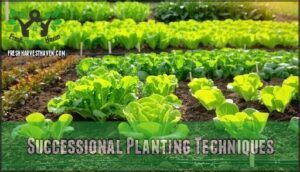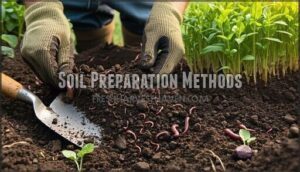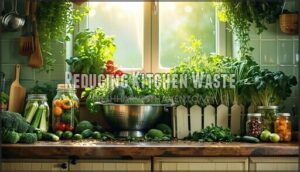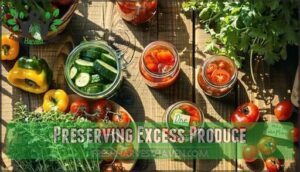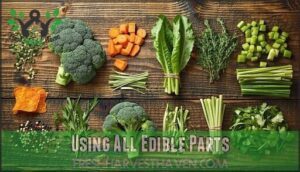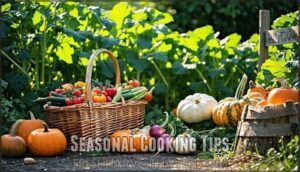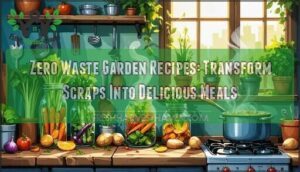This site is supported by our readers. We may earn a commission, at no cost to you, if you purchase through links.
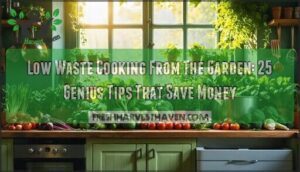
You’ll use every part of your vegetables – carrot tops become pesto, beet greens turn into sautés, and tomato stems flavor broths.
Plan your garden with succession planting to avoid overwhelming harvests, then preserve excess produce through freezing, dehydrating, and canning.
Create a composting system where kitchen scraps feed your soil, completing the cycle.
Root-to-stem cooking techniques help you discover new flavors while maximizing nutrition and minimizing waste.
Smart preservation methods and creative leftover recipes guarantee nothing goes unused, turning your garden abundance into year-round savings.
Table Of Contents
- Key Takeaways
- Garden Planning Essentials
- Reducing Kitchen Waste
- Low Waste Cooking Methods
- Sustainable Gardening Practices
- Seasonal Cooking Tips
- Frequently Asked Questions (FAQs)
- Does gardening reduce food waste?
- What is zero waste cooking techniques?
- How to cook for one without waste?
- What is the zero waste cooking trend?
- How does gardening reduce food waste?
- How to do zero waste cooking?
- What is a zero waste dish?
- How to handle garden crop failures?
- Can I use fermentation for garden scraps?
- Best tools for low waste food prep?
- Conclusion
Key Takeaways
- You’ll maximize your harvest and minimize waste by planning your garden with succession planting and choosing varieties that offer multiple edible parts – like beets with both greens and roots, or carrots with tops that become pesto.
- You can transform kitchen scraps into garden gold by composting vegetable peels, coffee grounds, and eggshells, then using this nutrient-rich compost to feed your soil and complete the growing cycle.
- You’ll save money and reduce food waste by using root-to-stem cooking techniques – turning carrot tops into pesto, broccoli stems into slaws, and vegetable scraps into flavorful broths instead of throwing them away.
- You can preserve your garden’s abundance through freezing, dehydrating, canning, and fermenting techniques that turn temporary surpluses into year-round pantry staples, eliminating the need to buy expensive out-of-season produce.
Garden Planning Essentials
You’ll save money and reduce waste by planning your garden with intention, selecting plants that produce multiple harvests and edible parts throughout the growing season.
Smart garden planning means choosing varieties suited to your climate and family’s eating habits, then organizing them using companion planting and succession techniques that maximize your space and minimize trips to the grocery store, ultimately leading to a more efficient use of space.
Choosing The Right Plants
Your plant selection blueprint determines whether you’ll harvest abundance or face garden disappointment. Climate Considerations and Family Preferences should guide every choice you make for sustainable Year-Round Success.
Your garden’s success starts with choosing plants that love your climate and feed your family’s favorites.
A key consideration is to utilize <strong>organic practices</strong> to promote a healthier garden.
Smart gardeners choose varieties with Multiple Edibles—like beets offering both greens and roots. Space Constraints demand compact plants over sprawling varieties.
Here’s your selection strategy:
- Research climate suitability for your hardiness zone
- Pick vegetables your family actually enjoys eating
- Choose plants with edible leaves, stems, and roots
- Select compact varieties for limited growing areas
Companion Planting Strategies
Smart companion planting creates natural partnerships that boost your garden’s productivity while cutting costs.
These strategic vegetable gardening tips deliver pest control and flavor enhancement without chemicals:
- Pest Deterrents: Plant marigolds with tomatoes to repel harmful insects naturally
- Pollinator Attraction: Add basil near peppers for beneficial bee activity
- Space Optimization: Pair tall corn with climbing beans for vertical growth support
This organic gardening approach improves soil health while maximizing your harvest potential.
This method often involves planting species together for mutual benefits.
Successional Planting Techniques
Staggered planting transforms your garden into a productivity powerhouse.
Plant small batches of fast-growing crops like lettuce and radishes every two weeks for continuous harvests.
This smart crop spacing prevents overwhelming surpluses while ensuring fresh produce flows steadily.
Choose quick-maturing varieties and mark planting dates on your calendar.
You’ll maximize extended yield from limited space while keeping waste minimal.
Soil Preparation Methods
After planning your planting schedule, focus on building nutrient-rich soil that feeds your plants naturally.
Test your soil first, then apply compost and worm castings for slow-release nutrition.
No-till gardening preserves beneficial microbes while cover cropping adds organic matter.
Mix kitchen scraps into your compost pile – they’ll break down into soil amendments that boost soil health without expensive fertilizers.
Reducing Kitchen Waste
You can cut your food waste nearly in half by collecting scraps for composting and storing produce properly.
These simple changes turn kitchen waste into garden gold while keeping your groceries fresh longer and your wallet fuller.
Collecting Kitchen Scraps
Three simple steps transform your kitchen scraps into garden gold.
Your kitchen scraps are tomorrow’s thriving garden—waste becomes wealth with simple composting magic.
First, choose Scrap Container Options like a 1-2 gallon bin with tight-fitting lid for efficient collection.
Charcoal Filter Usage controls unwanted odors while you gather kitchen scraps.
Smart Compost Bin Location means placing your container near your prep area for easy access.
Refrigeration Benefits prevent premature decomposition of wet food scraps.
These Odor Control Methods keep your kitchen fresh while collecting vegetable scraps.
Focus on suitable materials: food waste like coffee grounds, eggshells, and veggie peels.
Your composting system starts with proper scrap collection.
Composting Food Waste
Once you’ve gathered your kitchen scraps, transforming them into garden gold becomes your next money-saving move.
Composting food waste cuts household trash nearly in half while creating nutrient-rich soil amendments.
Start with a simple bin system: layer vegetable scraps with dry leaves, maintaining proper moisture levels.
Compost microorganisms break down materials faster when you turn the pile weekly.
For apartment dwellers, try vermicomposting benefits or the bokashi method for odor-free indoor composting.
To maintain activity during colder months, consider employing winter composting methods.
Troubleshoot common issues like slow decomposition by adjusting your carbon-to-nitrogen ratio.
You’ll eliminate fertilizer costs while supporting food waste reduction efforts.
Reducing Food Spoilage
Once you’ve composted those scraps, proper storage becomes your secret weapon against food spoilage.
Smart refrigeration and the FIFO Method can slash waste by 60%.
Here’s your battle plan:
- Temperature Control – Keep your fridge at 37°F to slow bacterial growth
- Strategic Placement – Store herbs in water jars and separate onions from potatoes
- Rotation System – Use First In, First Out to cycle older produce forward
Implementing FIFO storage solutions can further streamline this process.
These freezing techniques and food storage habits save serious money.
Repurposing Vegetable Scraps
Your fresh produce won’t last forever, but those scraps can work harder than you think.
Transform carrot tops and herb stems into flavorful Veggie Scrap Broth. Create Dehydrated Veggie Crisps from potato peels and beet skins.
Try Peel-Based Recipes like crispy parsnip chips or candied citrus rinds. Even Fermented Scraps like cabbage cores add tang to dishes.
Stems and Leaves become pesto ingredients. This roottostem cooking approach turns kitchen scraps into culinary gold while saving money.
Low Waste Cooking Methods
You can transform your garden harvest into multiple meals and preserve excess produce using simple techniques that prevent waste.
These cooking methods help you use every edible part of your vegetables while extending their shelf life through freezing, fermenting, and creative recipe adaptations.
Preserving Excess Produce
Your bumper harvest doesn’t have to overwhelm your kitchen. Smart food preservation transforms abundance into year-round savings through proven Freezing Techniques, Canning Safety protocols, and Dehydration Methods.
Preserving food extends your garden’s life:
- Freezing maintains peak freshness when you blanch vegetables first
- Canning creates shelf-stable tomatoes and pickles using proper sterilization
- Dehydrating concentrates flavors in herbs and fruits naturally
- Fermentation Benefits include probiotics plus extended storage from Pickling Recipes
To maintain quality when freezing, consider blanching vegetables beforehand. These methods turn temporary abundance into lasting kitchen treasures.
Using All Edible Parts
Your preserved produce is just the beginning—nutrient density hides in parts most people toss.
Carrot tops create vibrant pesto with bold flavor profiles, while broccoli stems add crunch to slaws.
Cooking with scraps transforms kitchen scraps into culinary innovation.
Those vegetable peels and fruit scraps aren’t waste—they’re recipe development opportunities.
Low waste cooking means waste reduction through creativity, turning herb stems into flavorful stocks and beet greens into nutritional powerhouses.
Creative Leftover Ideas
Yesterday’s roasted vegetables become today’s soup base with leftover transformations that stretch your budget.
Mix cold rice with eggs and garden herbs for quick fried rice.
Recipe adaptations work magic—turn pasta into salad, meat into sandwich filling, or cooked grains into breakfast bowls.
Ingredient swaps keep meals interesting while cooking with scraps reduces waste.
Smart portion control and creative flavor combinations transform ordinary leftovers into exciting new dishes your family will love.
Root-to-Stem Cooking Techniques
Most people toss perfectly good food without thinking twice. Root-to-stem cooking transforms your edible garden into a zero-waste powerhouse.
Those edible peels from potatoes become crispy chips. Carrot tops blend into vibrant pesto for stem recipes that pack serious root nutrition. Leafy greens from beets and radishes add peppery notes to salads.
Don’t forget seed utilization – roasted pumpkin seeds make fantastic snacks. This garden to table approach creates zero waste recipes that stretch your harvest further.
Sustainable eating starts with seeing potential in every plant part. Your wallet and the planet will thank you for this low waste cooking strategy. To maximize nutrients, consider steaming for preservation.
Sustainable Gardening Practices
You can create a thriving garden that produces more food while using fewer resources by implementing sustainable practices like crop rotation, water-saving techniques, and natural pest control.
These methods protect your soil’s health and reduce your reliance on expensive chemicals, creating a productive garden that’ll keep giving you fresh produce year after year with the help of sustainable practices.
Crop Rotation Strategies
Smart crop rotation annually disrupts pest lifecycle patterns while maximizing soil nutrients for sustainable gardening success.
This rotation benefits your garden planning by preventing disease buildup and reducing fertilizer costs.
Your rotation game plan:
- Family selection – Group plants by botanical families for easier tracking
- Planting schedule – Move heavy feeders after nitrogen-fixing legumes
- Soil health – Rotate deep-rooted crops with shallow ones
- Companion planting – Follow tomatoes with beans for natural fertilization
- Season mapping – Create simple charts tracking each bed’s history
Water Management Techniques
Efficient watering transforms your garden into a thriving oasis while slashing water bills.
Install drip irrigation systems that deliver moisture directly to plant roots, reducing water usage by 50% compared to traditional sprinklers. Consider using complete irrigation kits for efficient setup.
Rainwater harvesting through simple barrel collection provides free irrigation during dry spells. Apply thick mulching around plants to retain soil moisture and prevent evaporation.
These smart solutions boost nutrient uptake while maintaining ideal soil health throughout growing seasons.
Minimizing Chemical Use
Smart water management sets the stage for another money-saving strategy.
You don’t need expensive chemicals to protect your garden from pests. Create natural pesticides using garlic, chili peppers, and dish soap that cost pennies per batch.
Companion planting with marigolds and basil acts like a natural security system, deterring harmful insects while attracting beneficial insects.
These pest-resistant varieties and organic fertilizers like coffee grounds boost nutrient uptake without breaking your budget.
Your wallet and soil will thank you for choosing natural pest control methods.
Maintaining Soil Health
Think of soil as your garden’s foundation—without it, everything crumbles.
Healthy soil means healthy plants that resist pests naturally.
Mix worm castings and compost from kitchen scraps, coffee grounds, and eggshells for nutrient-rich soil enrichment.
Plant cover crops like clover between seasons.
No-till gardening preserves soil structure while composting methods transform waste into garden gold, creating sustainable growing conditions year-round.
Seasonal Cooking Tips
You’ll save money and reduce waste by cooking with what’s naturally available each season.
When you align your cooking with nature’s schedule, you’ll use fresh ingredients at their peak flavor while avoiding the higher costs of out-of-season produce, which is a key aspect of reducing waste and saving money by utilizing natural resources efficiently.
Spring Vegetable Recipes
Spring’s fresh greens transform your garden into a culinary goldmine.
You’ll discover asparagus inspiration in simple lemon-drizzled spears and pea dishes that celebrate their natural sweetness.
Create vibrant spring salads using tender lettuce and radish recipes featuring crisp roots with herb butter.
Don’t overlook rhubarb desserts – those tart stalks make incredible pies.
Seasonal cooking with fresh produce means spring vegetable recipes that maximize flavor while practicing low waste cooking from your own backyard harvest.
Roasting asparagus brings out natural sweetness, especially when roasted at 425°F.
Summer Harvest Ideas
Your garden’s abundance utilization peaks in summer when everything ripens at once.
Create fresh recipes like cucumber-tomato gazpacho or no-cook salads that showcase peak flavor.
Freeze grated zucchini in portion bags for winter baking, and make herb-infused olive oil ice cubes.
This garden bounty requires minimal preparation—fresh produce from your garden-to-table approach naturally shines with simple seasonal cooking techniques.
Fall Preserving Methods
After summer’s peak harvest, your garden bounty needs smart preservation to avoid waste.
Fall’s cooler weather creates perfect conditions for long-term food storage that’ll stretch your harvest through winter months.
Transform your surplus into pantry gold with these proven methods:
- Canning – Make apple sauce and pumpkin butter for shelf-stable spreads
- Dehydrating – Create herb drying stations for concentrated flavors year-round
- Fermenting – Turn excess vegetables into probiotic-rich fermented vegetables
- Root cellaring – Store hardy vegetables naturally without electricity
Winter Meal Planning Strategies
Cold weather calls for smart seasonal cooking strategies that stretch your garden’s bounty.
Store root vegetables properly and prioritize them in hearty winter soups. Transform preserved ingredients into warming meals when fresh options dwindle.
| Storage Solutions | Recipe Adaptations |
|---|---|
| Root vegetables in cool, dry spaces | Soups using frozen garden produce |
| Fermented cabbage for flavor boosts | Stews incorporating leftover vegetables |
| Preserved ingredients for variety | Budget conscious family-friendly meals |
Frequently Asked Questions (FAQs)
Does gardening reduce food waste?
Yes, gardening substantially reduces food waste.
You’ll harvest only what you need, use every part of plants you grow, and compost scraps back into soil, creating a sustainable cycle that minimizes waste.
What is zero waste cooking techniques?
Zero waste cooking uses every part of ingredients you’d normally discard.
Transform carrot tops into pesto, potato peels into chips, and vegetable scraps into flavorful broth.
You’ll save money while reducing landfill waste substantially, which is a key benefit of zero waste cooking.
How to cook for one without waste?
Portion perfectly by planning single-serving meals and buying smaller quantities.
You’ll freeze leftovers in individual containers, repurpose vegetable scraps into stocks, and choose versatile ingredients that work across multiple dishes throughout the week.
What is the zero waste cooking trend?
This sustainable cooking movement focuses on using every part of your food—from vegetable scraps to leftovers.
You’ll transform potato peels into chips, carrot tops into pesto, and reduce household waste substantially.
How does gardening reduce food waste?
Like a well-oiled machine, your garden eliminates the middleman between soil and plate.
You’ll harvest only what you need, use every plant part from root to stem, and compost scraps back into nutrient-rich soil.
How to do zero waste cooking?
Plan meals around what you already have, use every part of vegetables from stems to peels, transform leftovers into new dishes, and compost scraps to close the loop completely.
What is a zero waste dish?
Transform your kitchen scraps into culinary gold!
You’ll create zero waste dishes by using every part of vegetables—carrot tops become pesto, broccoli stems join stir-fries, and potato peels turn into crispy chips.
How to handle garden crop failures?
Don’t panic when crops fail—it’s part of gardening.
Compost failed plants to enrich soil.
Plant cover crops or quick-growing greens.
Buy from local farmers to maintain your zero-waste cooking while planning next season’s improvements to achieve complete gardening success.
Can I use fermentation for garden scraps?
Fermentation’s like alchemy for your garden scraps.
You can ferment vegetable trimmings, peels, and stems into flavorful ingredients.
Try fermenting carrot tops, radish greens, or cauliflower leaves. They’ll develop tangy, complex flavors perfect for cooking.
Best tools for low waste food prep?
A sharp chef’s knife, cutting boards for different foods, glass storage containers, and a food processor will streamline your prep work.
You’ll save time while maximizing every scrap and vegetable part efficiently.
Conclusion
Seeds of wisdom grow into sustainable abundance when you embrace low waste cooking from the garden.
Your kitchen becomes a cycle of renewal where scraps transform into soil and surplus harvests feed your family year-round.
You’ll discover that every carrot top, beet green, and tomato stem holds potential for delicious meals.
By implementing these 25 techniques, you’re not just reducing waste—you’re cultivating a mindful approach to food that saves money while nourishing both body and earth.
- https://www.researchgate.net/publication/386373223_From_Root_to_Stem_Optimizing_Produce_Utilization_and_Reducing_Waste_through_Sustainable_Cooking_Practices
- https://www.tandfonline.com/doi/full/10.1080/23311886.2024.2388178
- https://www.epa.gov/sustainable-management-food/sustainable-management-food-basics
- https://www.sciencedirect.com/science/article/pii/S0921344925001752
- https://sustainablejungle.com/newsletter/


